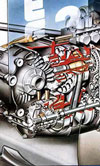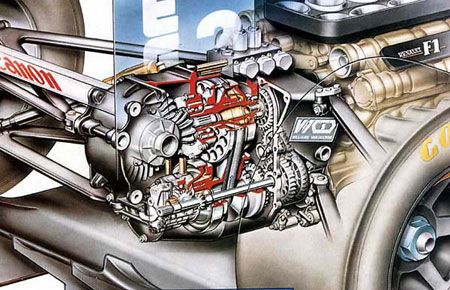Transmission
 More than 15 years ago, a young David Coulthard said he was "very excited" about a new development at Williams, going on to say that "machine is working better than man". The reason for his enthusiasm was that he had just tested Williams' revolutionary continuously variable transmission (CVT) system. This was in 1993, and the system so worried other competitors and the FIA that it was banned before it could be raced. There is video on the internet of the car being tested in CVT guise, and it is well worth watching - and listening to.
More than 15 years ago, a young David Coulthard said he was "very excited" about a new development at Williams, going on to say that "machine is working better than man". The reason for his enthusiasm was that he had just tested Williams' revolutionary continuously variable transmission (CVT) system. This was in 1993, and the system so worried other competitors and the FIA that it was banned before it could be raced. There is video on the internet of the car being tested in CVT guise, and it is well worth watching - and listening to.
Mated to the current Renault V10, the CVT allowed the engine to run at a constant speed where power output was greatest, and for the transmission ratio to be controlled to provide the optimum tractive effort. Arnaud Boulanger, who now holds a senior role at the Renault Formula One team, was involved in the project at the time and gave us his insight.
If you watch the video footage of the test, you will notice that the noise of the car is almost constant. "Most people at the time thought it would spoil or destroy the show to the public because one could not relate noise to speed," says Boulanger. "I honestly believe the fans would have hated it".
The only variation in sound comes when the car drives from its 12,500 rpm 'idle' speed corresponding to peak torque, used for launch, to its constant 15,000 rpm running speed (peak power engine speed in 1993). The potential advantage of the CVT was described as "massive" - the average power around a given lap would have been a vast increase over a car equipped with discrete ratios.
Little engine work was done for the brief testing, but it is certain that the engine would have had to have been changed to cope with the requirements of CVT.

The first of two obvious points is that, for CVT use, the engine would be optimised around a single speed rather than the convention of being tuned such that it is driveable over a wide range. The second important impact of CVT on the engine is that the duty cycle is very much greater, and therefore many of the components would need to be redesigned to withstand the rigours of being operated at constant high speed and load. There is little doubt that this could be achieved, but it would have taken some work at the time.
I asked Boulanger his opinion about the 'arms race' that CVT would have brought to Formula One. Would everyone have had to develop CVT, had it not been banned by the FIA? "Yes - not because the public would have liked it, but they would have been forced into it," he says.
Despite the fact that Boulanger believes that the public would have hated CVT in Formula One, such was its potential advantage that everyone would have been forced to follow because the penalty of not doing so would be so damaging. In the next issue of RET-Monitor we will look at some other aspects of this fascinating project.
Fig. 1 - A cutaway illustration of the CVT system
Written by Wayne Ward